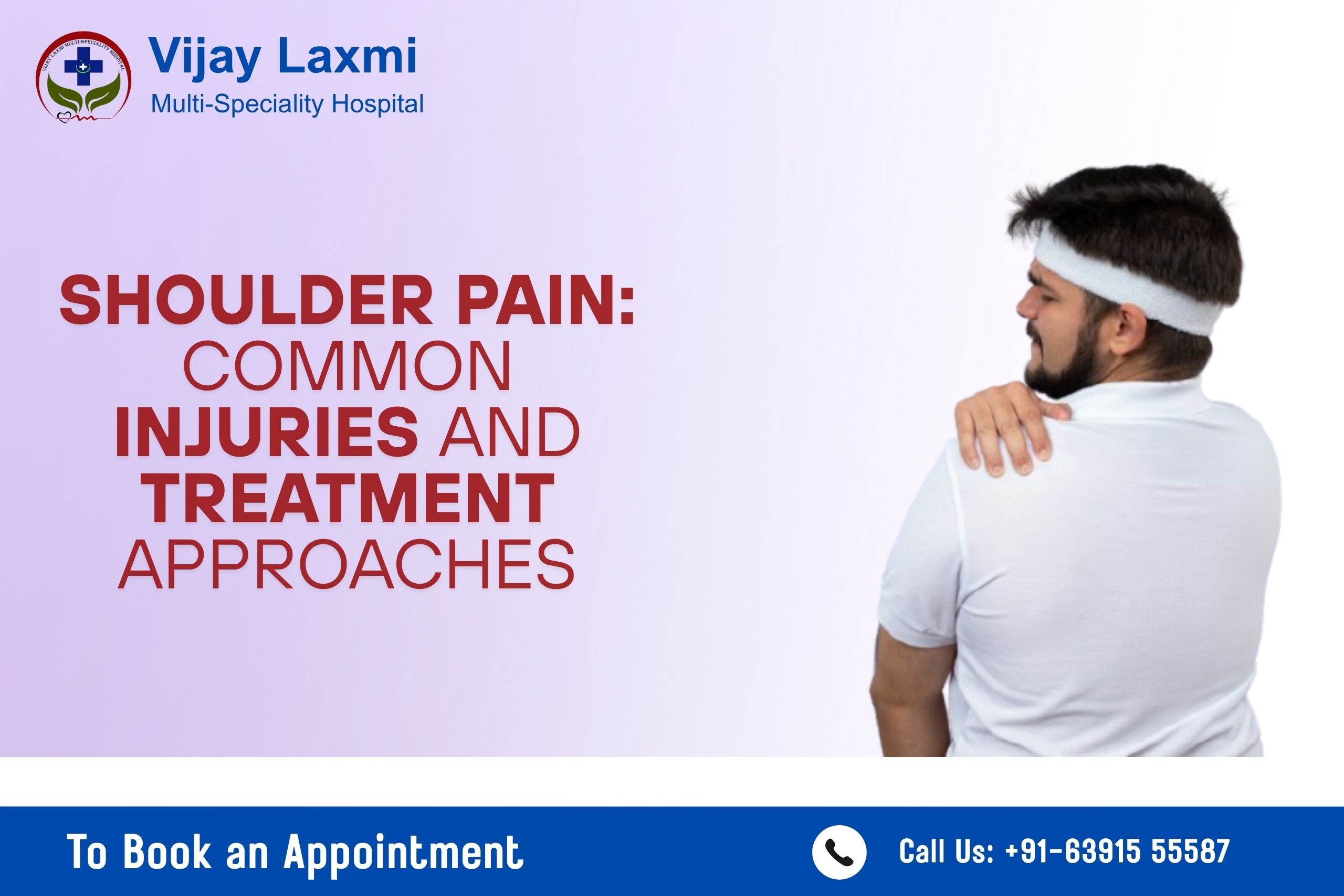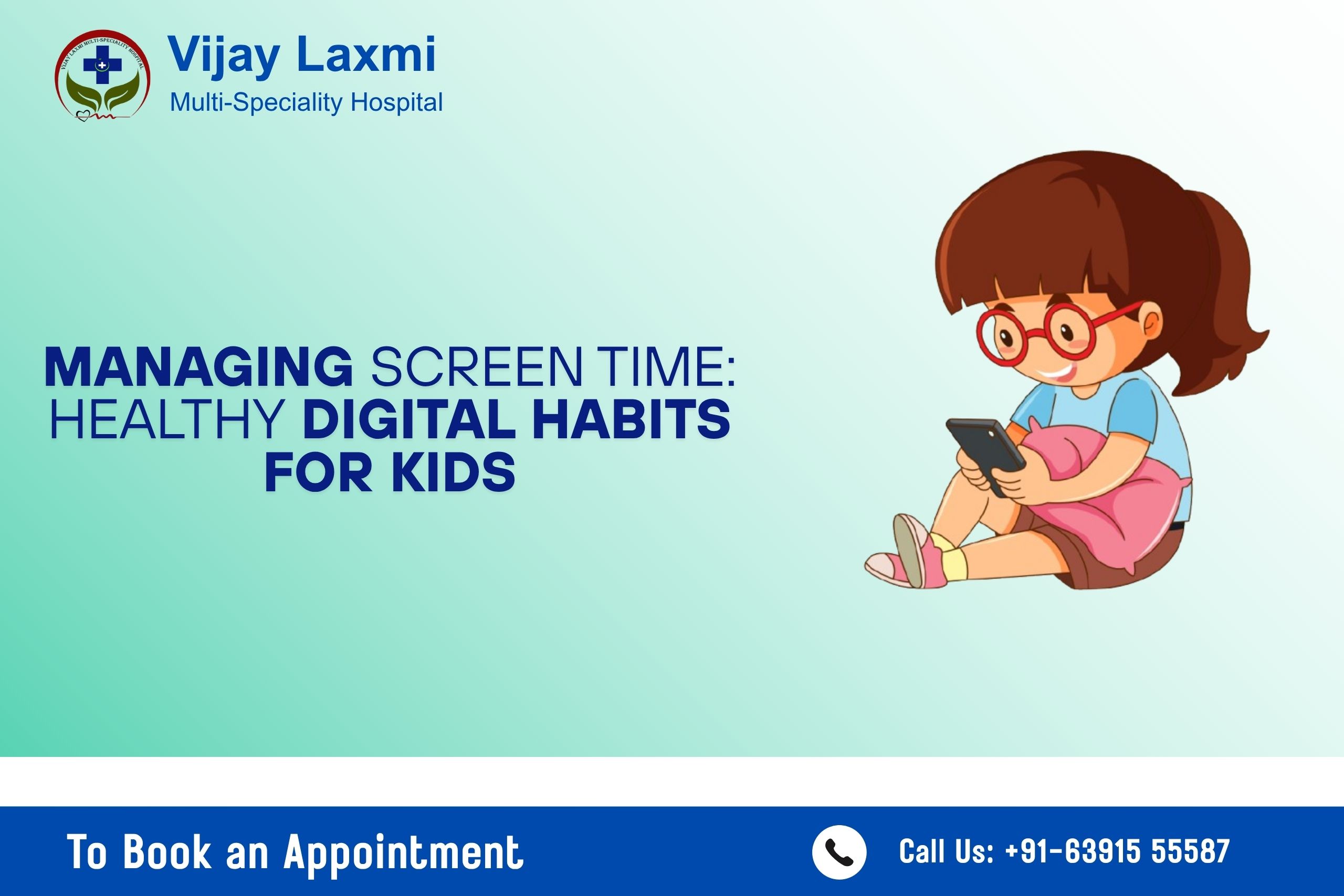
Shoulder Pain: Common Injuries and Treatment Approaches
Shoulder pain is one of the most common musculoskeletal complaints seen in orthopedic clinics. Whether it’s caused by overuse, injury, poor posture, or age-related wear and tear, shoulder pain can severely limit your ability to perform daily activities like lifting, reaching, or even sleeping comfortably.
At Vijay Laxmi Multi-Speciality Hospital, Jaunpur, Dr. Ayush Patel, best orthopedic doctor specializing in shoulder pain treatment in Jaunpur, provides advanced, evidence-based care for all types of shoulder conditions. From diagnosis to physiotherapy and rehabilitation, his holistic approach ensures that patients not only recover from pain but also regain strength and long-term mobility.
In this blog, we’ll explore the common causes of shoulder pain, diagnostic methods, treatment options, and lifestyle tips recommended by Dr. Ayush Patel to help you manage and prevent shoulder injuries effectively.
Understanding Shoulder Pain: Why It Happens
The shoulder joint is one of the most mobile joints in the human body, allowing a wide range of motion. However, this flexibility also makes it prone to instability and injury. Shoulder pain can stem from muscles, tendons, ligaments, cartilage, or even nerves surrounding the joint.
According to Dr. Ayush Patel, the most frequent causes of shoulder pain include:
- Overuse injuries from repetitive movements (common in athletes and manual laborers)
- Degenerative changes like arthritis or tendon wear
- Poor posture from prolonged sitting or slouching
- Sudden trauma such as falls or lifting heavy objects incorrectly
- Inflammatory conditions like bursitis or tendinitis
Identifying the root cause is crucial because shoulder pain can range from a mild muscle strain to serious conditions such as a rotator cuff tear or frozen shoulder.
Common Shoulder Injuries and Conditions
1. Rotator Cuff Injury
The rotator cuff consists of four muscles and tendons that stabilize the shoulder joint. Injury or strain to these tendons often due to repetitive motion or aging can lead to pain, weakness, and limited movement.
Symptoms:
- Pain when lifting or rotating the arm
- Weakness in shoulder strength
- Difficulty sleeping on the affected side
Treatment:
Dr. Ayush Patel recommends rest, physiotherapy, and anti-inflammatory medication for mild cases. For partial or complete tears, arthroscopic repair surgery may be advised. Post-surgery rehabilitation ensures full recovery of motion.
2. Frozen Shoulder (Adhesive Capsulitis)
Frozen shoulder causes stiffness and severe pain due to inflammation and thickening of the joint capsule. It commonly affects people aged 40–60 and can develop after an injury, surgery, or prolonged immobilization.
Symptoms:
- Gradual onset of shoulder stiffness
- Pain even during rest or sleep
- Restricted movement in all directions
Treatment:
Early intervention with physiotherapy, heat therapy, and gentle stretching exercises plays a vital role. In some cases, steroid injections or arthroscopic release procedures may be necessary.
3. Shoulder Impingement Syndrome
Impingement occurs when shoulder tendons get trapped and irritated between the bones during movement. It’s common among swimmers, painters, and individuals performing overhead tasks.
Symptoms:
- Pain during overhead motion
- Shoulder weakness
- Clicking or grinding sensation
Treatment:
Conservative management is often effective, including anti-inflammatory medications, ultrasound therapy, and structured physiotherapy sessions. Dr. Ayush Patel emphasizes posture correction and strengthening exercises to prevent recurrence.
4. Bursitis and Tendinitis
Inflammation of the bursa (a fluid-filled sac that cushions the joint) or shoulder tendons can result from repetitive activities or minor trauma.
Symptoms:
- Dull ache that worsens with movement
- Swelling around the shoulder
- Pain when lying on the affected side
Treatment:
Mild cases usually improve with rest, ice application, and physical therapy. For persistent inflammation, corticosteroid injections or ultrasound-guided aspiration may be used.
5. Shoulder Dislocation
A dislocated shoulder occurs when the upper arm bone pops out of its socket often due to a sports injury or fall. Once it happens, the joint becomes more susceptible to future dislocations.
Symptoms:
- Visible deformity or swelling
- Intense pain and inability to move the arm
- Numbness or tingling sensation
Treatment:
Emergency care is required to realign the joint. Afterward, immobilization, physiotherapy, and strengthening exercises are essential for recovery. Chronic instability may require arthroscopic stabilization surgery.
6. Arthritis of the Shoulder
Shoulder arthritis results from cartilage degeneration within the joint, leading to stiffness, swelling, and pain especially in older adults.
Symptoms:
- Dull, deep pain in the shoulder joint
- Loss of motion and creaking sounds
- Morning stiffness
Treatment:
Dr. Ayush Patel offers both medical management (anti-inflammatory drugs, physiotherapy) and surgical options like shoulder joint replacement in severe cases. Regular range-of-motion exercises can slow disease progression.
Diagnosis: How Shoulder Pain Is Evaluated
At Vijay Laxmi Multi-Speciality Hospital, Jaunpur, diagnosis begins with a detailed clinical examination and medical history review. Dr. Ayush Patel uses advanced diagnostic tools to pinpoint the cause of shoulder pain, including:
X-rays – To assess bone alignment and detect fractures or arthritis
MRI scans – For soft tissue evaluation (rotator cuff, tendons, ligaments)
Ultrasound imaging – To identify fluid build-up or tendon inflammation
Physical assessments – To evaluate range of motion and muscular strength
This comprehensive evaluation ensures that each patient receives a targeted, personalized treatment plan rather than generalized pain relief.
Treatment Approaches for Shoulder Pain
1. Medication and Pain Management
For acute shoulder pain, non-steroidal anti-inflammatory drugs (NSAIDs) are commonly prescribed to reduce swelling and pain. In cases of chronic inflammation, steroid injections or viscosupplementation may be recommended.
2. Physiotherapy and Rehabilitation
Physiotherapy is a cornerstone of shoulder pain treatment at Vijay Laxmi Multi-Speciality Hospital. Under expert supervision, patients undergo exercises to restore flexibility, strengthen muscles, and improve joint mobility.
Common physiotherapy techniques include:
- Pendulum exercises for range of motion
- Resistance band workouts for shoulder strength
- Heat and ultrasound therapy for pain reduction
- Posture correction and ergonomic training
3. Non-Surgical Interventions
For patients who prefer non-surgical options, several advanced procedures are available:
- PRP (Platelet-Rich Plasma) Therapy – Helps repair damaged tendons naturally.
- Hydrodilatation – Used in frozen shoulder to release joint stiffness.
- Ultrasound-guided injections – Offer precise delivery of medication to reduce inflammation.
These treatments, combined with physiotherapy, can significantly enhance pain relief and joint function.
4. Surgical Treatment
If conservative management fails or in cases of severe structural damage, minimally invasive shoulder surgery is performed by Dr. Ayush Patel. These include:
- Arthroscopic rotator cuff repair
- Shoulder stabilization surgery
- Joint replacement (arthroplasty)
The hospital’s modern orthopedic operation theater ensures patient safety, precision, and faster post-surgery recovery.
Recovery and Prevention Tips
To prevent recurrence of shoulder pain, Dr. Ayush Patel recommends adopting simple yet effective lifestyle changes:
Maintain Good Posture
Avoid slouching or hunching while sitting at a desk or using a phone. Keep shoulders relaxed and aligned.
Stay Physically Active
Perform shoulder stretching and strengthening exercises regularly. Activities like swimming or yoga help maintain flexibility.
Avoid Overuse
Take frequent breaks during repetitive tasks. Gradually increase intensity during workouts to prevent strain.
Apply Ice or Heat
Use ice packs for acute injuries and warm compresses for chronic stiffness.
Choose Ergonomic Aids
Use supportive pillows, ergonomic chairs, and avoid carrying heavy bags on one shoulder.
When to See an Orthopedic Doctor in Jaunpur
Seek immediate consultation if you experience:
- Sudden or severe shoulder pain
- Persistent stiffness for more than 2–3 weeks
- Swelling or redness around the shoulder joint
- Numbness or tingling in the arm
- Shoulder weakness or loss of function
Delaying treatment can lead to chronic pain and permanent damage. Early intervention at Vijay Laxmi Multi-Speciality Hospital ensures faster recovery and prevents complications.
Why Choose Vijay Laxmi Multi-Speciality Hospital for Shoulder Pain Treatment in Jaunpur
- Experienced Orthopedic Specialist: Dr. Ayush Patel brings years of expertise in diagnosing and treating complex shoulder conditions.
- Advanced Imaging and Diagnostics: On-site digital X-rays for accurate assessment.
- Integrated Physiotherapy Unit: Personalized rehabilitation programs under professional supervision.
- Patient-Centered Care: Transparent communication, ethical treatment, and compassionate guidance.
- Comprehensive Recovery Plans: From medication to surgery and physiotherapy—all under one roof.
Whether you are an athlete, office worker, or senior citizen, Dr. Ayush Patel and his team provide the best shoulder pain treatment in Jaunpur, tailored to your condition and recovery goals.
Conclusion
Shoulder pain doesn’t have to limit your daily life. With the right diagnosis, treatment, and physiotherapy, you can regain mobility and live pain-free. At Vijay Laxmi Multi-Speciality Hospital, Dr. Ayush Patel’s integrated approach combining medical expertise, advanced technology, and personalized care ensures the best possible outcomes for every patient.
If you’re struggling with shoulder pain or stiffness, don’t wait for it to worsen. Book your consultation today and take the first step toward a healthier, stronger
Call Us: 063915 55587
Visit Us: Laxmi Complex, Jaycees Chauraha, Azamgarh Rd, Pratap Colony, Jaunpur, Uttar Pradesh 222002
Disclaimer:
The information provided in this article is for educational and informational purposes only and is not a substitute for professional medical advice, diagnosis, or treatment. Always consult a qualified healthcare provider











